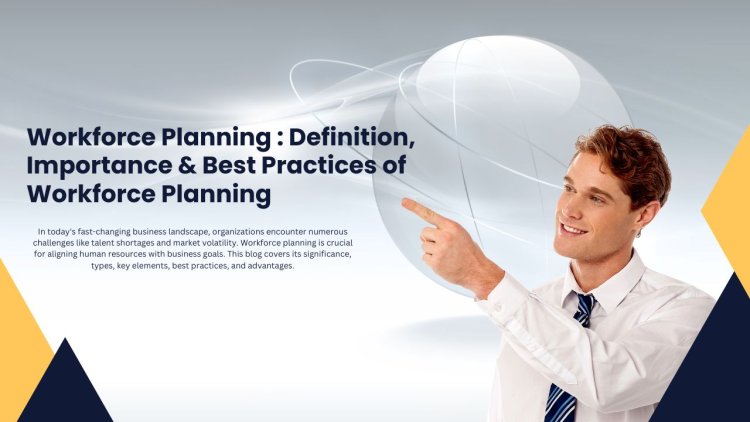Workforce Planning Guide: Definition, Importance & Best Practices
In today's fast-changing business landscape, organizations encounter numerous challenges like talent shortages and market volatility. Workforce planning is crucial for aligning human resources with business goals. This blog covers its significance, types, key elements, best practices, and advantages.
Share this Post to earn Money ( Upto ₹100 per 1000 Views )

In today's ever-evolving business landscape, workforce planning has emerged as a critical strategic practice for organisations of all sizes. The dynamic nature of the global economy, coupled with technological advancements and changing demographic trends, necessitates a proactive approach to managing a company's most valuable asset - its workforce. In this comprehensive guide, we delve into the intricacies of workforce planning, defining its essence, exploring its profound importance, and highlighting the best practices that can elevate your organisation's competitive edge.
What is Workforce Planning?
Workforce planning, at its core, is the systematic process of identifying and addressing an organisation's current and future workforce needs. It involves assessing the skills, knowledge, and competencies required to achieve business objectives and ensuring that the right people with the right capabilities are in the right positions at the right time. Effective workforce planning goes beyond simple headcount management; it aligns human capital with strategic goals, fostering growth, innovation, and adaptability.
The Importance of Workforce Planning
1. Strategic Alignment
Workforce planning serves as the linchpin connecting an organisation's strategic objectives with its human resources. By mapping out future workforce requirements, it enables companies to identify talent gaps and proactively develop strategies to fill them. This alignment ensures that every hire and promotion contributes directly to the company's overarching goals.
2. Cost Management
Inefficient workforce management can result in overstaffing or understaffing, both of which have detrimental financial implications. Workforce planning helps in optimising staff levels, minimising labour costs, and maximising productivity. By aligning staffing levels with business demands, you can eliminate unnecessary expenditures and enhance profitability.
3. Talent Acquisition and Retention
In a competitive job market, attracting and retaining top talent is a perennial challenge. Workforce planning facilitates proactive recruitment efforts, enabling companies to identify future talent needs and build a pipeline of skilled professionals. It also aids in creating a workplace that values and retains high-performing employees, reducing turnover and its associated costs.
4. Adaptability and Innovation
The business environment is subject to constant change, and organisations must be agile to thrive. Workforce planning equips companies with the ability to respond quickly to emerging opportunities and challenges. By identifying skills gaps and nurturing talent development, organisations can innovate and adapt in an ever-evolving landscape.
Best Practices in Workforce Planning
1. Data-Driven Decision Making
The foundation of effective workforce planning lies in data. Leveraging analytics, companies can gain insights into current workforce demographics, skills, and performance. This data-driven approach enables informed decision-making regarding staffing levels, skills development, and talent acquisition.
2. Collaboration Across Departments
Workforce planning is not the sole responsibility of the HR department. It requires collaboration between HR, finance, operations, and senior management. Cross-functional input ensures that the workforce strategy aligns seamlessly with broader business goals.
3. Scenario Planning
Given the unpredictability of the business environment, scenario planning is crucial in workforce planning. Companies should consider various potential scenarios, such as economic downturns or rapid expansion, and develop strategies to address these contingencies.
4. Continuous Evaluation and Adjustment
Workforce planning is not a one-time effort but an ongoing process. Regularly assess the effectiveness of your workforce strategy and adjust it in response to changing business conditions. This adaptability ensures that your organisation remains competitive and agile.
Conclusion
In conclusion, workforce planning is not a mere HR function but a strategic imperative for organisations aiming to thrive in today's dynamic marketplace. By defining its essence, understanding its profound importance, and embracing best practices, businesses can harness the power of workforce planning to optimise their human capital and secure a sustainable competitive advantage. As you embark on your journey towards effective workforce planning, remember that it's not just about the number of employees but about the right employees, in the right roles, at the right time.







